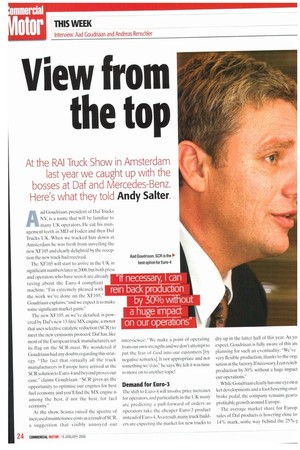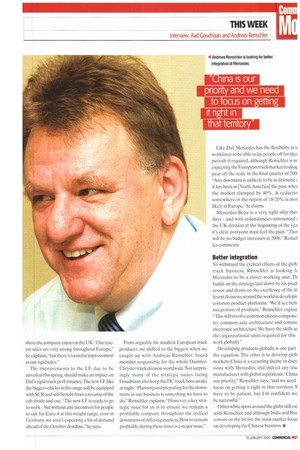View from the top
Page 24

Page 25

If you've noticed an error in this article please click here to report it so we can fix it.
At the RAI Truck Show in Amsterdam last year we caught up with the bosses at Daf and Vercedes-Benz.
Here's what they told Andy Salter Aad Goudriaan. president of Daf Trucks NV, is a name that will he familiar to many UK operators. Fle cut his management teeth as MD of Foden and then Daf Trucks UK. When we tracked him down at Amsterdam he was fresh from unveiling the new XF105 and clearly delighted by the reception the new truck had received.
The XF105 will start to arrive in the UK in significant numbers later in 2006. but both press and operators who have seen it are already raving about the Euro-4 compliant machine. "I'm extremely pleased with the work we've done on the XF105," Goudriaan explains, "and we expect it to make some significant market gains."
The new XF105. as we've detailed, is powered by Dais new 13-litre MX engine, a motor that uses selective catalytic reduction (SCR) to meet the new emissions protocol. Daf has, like most of the European truck manufacturers, set its flag on the SCR mast. We wondered if Goudriaan had any doubts regarding this strategy. "The fact that virtually all the truck manufacturers in Europe have arrived at the SCR solution to Euro-4 and beyond proves our case." claims Goudriaan. "SCR gives us the opportunity to optimise our engines for best fuel economy and you'll find the MX engine is among the best, if not the best. for fuel economy."
At the show. Scania raised the spectre of increased maintenance costs as a result of SCR. a suggestion that visibly annoyed our
interviewee: "We make a point of operating from our own strengths and we don't attempt to put the fear of God into our customers I by negative remarks]. It not appropriate and not something we'd do." he says. We felt it was time to move on to another topic!
Demand for Euro-3
The shift to Euro-4 will involve price increases for operators, and particularly in the UK many arc predicting a pull-forward of orders as operators take the cheaper Euro-3 product instead of Euro4.As a result.many truck builders are expecting the market for new trucks to
dry up in the latter half of this year. As yo expect, Goudriaan is fully aware of this an planning for such an eventuality: "We've very flexible production, thanks to the org sation at the factory. If nece.s.sary, I can rein b production by 30% without a huge impact our operations,"
While Goudriaan clearly has one eye on n ket developments and a foot hovering over brake pedal, the company remains gearei profitable growth around Europe.
The average market share for Europ sales of Daf products is hovering close to 14% mark, some way behind the 25%-i
share the company enjoys in the UK."Our tractor sales are very strong throughout Europe," he explains.-but there's room for improvement in our rigid sales."
The improvements to the LF. due to be unveiled this spring, should make an impact on Dais rigid truck performance.The new LF,Iike the bigger vehicles in the range,will be equipped with SCR and will benefit from a revamp of the cab inside and out. -The new LF is ready to go to work hut without any incentives for people to opt for Euro-4 at this weight range. even in Germany, we aren't expecting a lot of demand ahead of the October deadline," he says. From arguably the smallest European truck producer, we shifted to the biggest when we caught up with Andreas Renschler, board member responsible for the whole DaimlerChrysler truck division worldwide. Not surprisingly, many of the strategic issues facing Goudriaan also keep the DC truck boss awake at night. "Planning and preparing for the downturns in our business is something we have to do," Renschler explains. "However, a key strategic issue for us is to ensure we remain a profitable company throughout the cyclical downturns of differing markets. How to remain profitable during these times is a major issue." Like Daf. Mercedes has the flexibility in ii workforce to be able to lay people off for shoi periods if required, although Renschler is nc expecting the European truck market to disar pear off the scale in the final quarter of 200 "Any downturn is unlikely to be as dramatic r it has been in [North America] the past, whet the market slumped by 40%. A reductio somewhere in the region of 18-20% is mot likely in Europe," he claims.
Mercedes-Benz is a very tight ship thes days and with redundancies announced the UK division at the beginning of the yea it's clear everyone must feel the pain. "Thei will be no budget increases in 2006." Renscl ler comments.
Better integration To withstand the cyclical effects of the glob truck business, Renschler is looking I.( Mercedes to he a closer working unit. Th builds on the strategy laid down by his pred cessor and draws on the excellence of the di ferent divisions around the world in developir common product platforms. "We'll see butti integration of products." Renschler explair -This will involve common chassis compone try. common axle architecture and commc electronic architecture. We have the skills ar the organisational units required for this work globally."
Developing products globally is one part the equation. The other is to develop glob markets. China is a recurring theme in disci] sions with Mercedes, and indeed any tru( manufacturer with global aspirations."China our priority," Renschler says, -and we need focus on getting it right in that territory. V have to be patient, but I'm confident we be successful."
Other white spots around the globe still exi adds Renschler. and although India and Bra remain on the hit list, the main market focus on developing the Chinese business.
































































































































































































